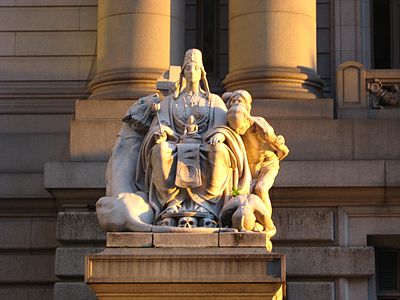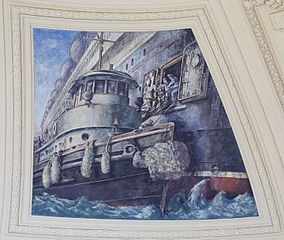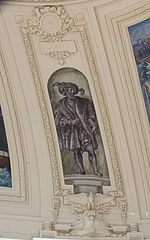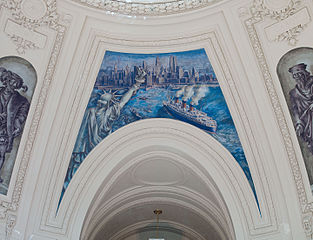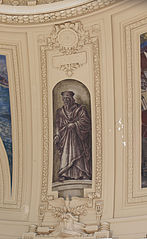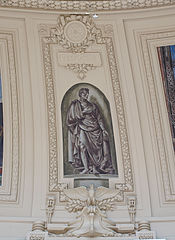Alexander Hamilton U.S. Custom House: Difference between revisions
m →Architecture: http→https for Google Books and Google News using AWB |
Rescuing 1 sources and tagging 0 as dead. #IABot (v1.2.7) |
||
| Line 27: | Line 27: | ||
Constructed between 1902 and 1907, the building is considered to be a masterpiece of the [[Beaux-Arts architecture|Beaux-Arts style]], where public transactions were conducted under a noble Roman dome. It incorporates Beaux Arts and [[City Beautiful movement]] planning principles, combining architecture, engineering, and fine arts. Lavish sculptures, paintings, and decorations by well-known artists of the time, such as [[Daniel Chester French]], [[Karl Bitter]], [[Louis St. Gaudens]] and [[Albert Jaegers]], embellish the facade, the two-story entry portico, the main hall parallel to the facade, the Rotunda, and the Collector's Reception Room. |
Constructed between 1902 and 1907, the building is considered to be a masterpiece of the [[Beaux-Arts architecture|Beaux-Arts style]], where public transactions were conducted under a noble Roman dome. It incorporates Beaux Arts and [[City Beautiful movement]] planning principles, combining architecture, engineering, and fine arts. Lavish sculptures, paintings, and decorations by well-known artists of the time, such as [[Daniel Chester French]], [[Karl Bitter]], [[Louis St. Gaudens]] and [[Albert Jaegers]], embellish the facade, the two-story entry portico, the main hall parallel to the facade, the Rotunda, and the Collector's Reception Room. |
||
Sculpture was so crucial to the scheme that the figure groups had independent contracts. The major work across the front steps, ''The Continents'', also called the ''Four Continents'', of Asia, America, Europe, and Africa, was contracted to French, with associate [[Adolph A. Weinman]].<ref>{{cite web|last=van Alfen|first=Peter|title=Monuments, Medals, and Metropolis, part I: Beaux Arts Architecture|url=http://ansmagazine.com/Summer03/Monuments}}</ref> Above the main cornice are standing sculptures representing the great seafaring nations, representing American seagoing commerce as the modern heir of the Phoenicians. |
Sculpture was so crucial to the scheme that the figure groups had independent contracts. The major work across the front steps, ''The Continents'', also called the ''Four Continents'', of Asia, America, Europe, and Africa, was contracted to French, with associate [[Adolph A. Weinman]].<ref>{{cite web|last=van Alfen |first=Peter |title=Monuments, Medals, and Metropolis, part I: Beaux Arts Architecture |url=http://ansmagazine.com/Summer03/Monuments |deadurl=yes |archiveurl=https://web.archive.org/web/20140112004346/http://ansmagazine.com:80/Summer03/Monuments |archivedate=2014-01-12 |df= }}</ref> Above the main cornice are standing sculptures representing the great seafaring nations, representing American seagoing commerce as the modern heir of the Phoenicians. |
||
In 1937, during the [[Great Depression in the United States|Great Depression]], the [[Treasury Relief Art Project]] (with funds and assistance from the [[Works Projects Administration]]) commissioned a cycle of murals for the main rotunda from [[Reginald Marsh (artist)|Reginald Marsh]].<ref>{{cite web |url=https://livingnewdeal.org/projects/u-s-custom-house-murals-new-york-ny/ |title=U.S. Custom House Murals – New York NY |website=[[Living New Deal]] |publisher=Department of Geography, University of California, Berkeley |access-date=2016-04-25}}</ref><ref name="O'Connor">{{cite journal |last=O'Connor |first=Francis V. |date=Autumn 1969 |title=The New Deal Art Projects in New York |journal=The American Art Journal |publisher=Kennedy Galleries, Inc. |volume=1 |issue=2 |pages=58–79 |jstor=1593876 }}</ref>{{Rp|62–63}} |
In 1937, during the [[Great Depression in the United States|Great Depression]], the [[Treasury Relief Art Project]] (with funds and assistance from the [[Works Projects Administration]]) commissioned a cycle of murals for the main rotunda from [[Reginald Marsh (artist)|Reginald Marsh]].<ref>{{cite web |url=https://livingnewdeal.org/projects/u-s-custom-house-murals-new-york-ny/ |title=U.S. Custom House Murals – New York NY |website=[[Living New Deal]] |publisher=Department of Geography, University of California, Berkeley |access-date=2016-04-25}}</ref><ref name="O'Connor">{{cite journal |last=O'Connor |first=Francis V. |date=Autumn 1969 |title=The New Deal Art Projects in New York |journal=The American Art Journal |publisher=Kennedy Galleries, Inc. |volume=1 |issue=2 |pages=58–79 |jstor=1593876 }}</ref>{{Rp|62–63}} |
||
Revision as of 23:50, 9 November 2016
40°42′15″N 74°00′50″W / 40.704294°N 74.013773°W
U.S. Custom House | |
 (2008) | |
| Location | 1 Bowling Green Manhattan, New York City |
|---|---|
| Built | 1901-1907 |
| Architect | Cass Gilbert, Daniel Chester French |
| Architectural style | Beaux-Arts |
| NRHP reference No. | 72000889[1] |
| Significant dates | |
| Added to NRHP | January 31, 1972 |
| Designated NHL | December 8, 1976[1] |
The Alexander Hamilton U.S. Custom House is a building in New York City built in 1902–07 by the federal government, to house the duty collection operations for the Port of New York. It is located at 1 Bowling Green, near the southern tip of Manhattan, roughly on the same spot as Fort Amsterdam, the original center of the settlement of New Amsterdam. The building is now the home of the George Gustav Heye Center of the National Museum of the American Indian, as well as the United States Bankruptcy Court for the Southern District of New York; since 2012, it is also the home to the National Archives at New York City.
Architecture
The building was designed by Minnesotan Cass Gilbert, who later designed the Woolworth Building, which is visible from the building's front steps. The selection of Gilbert to design the building was marked with controversy. Until 1893, federal office buildings were designed by government architects under the Office of the Supervising Architect of the United States Department of the Treasury. In 1893, the Tarsney Act permitted the Supervising Architect to hire private architects following a competition. The Supervising Architect James Knox Taylor picked Gilbert, who earlier had been his partner at the Gilbert & Taylor architecture firm in St. Paul, Minnesota. The scandal never quite blew over, and in 1913, the Tarsney Act was repealed.[2]
Constructed between 1902 and 1907, the building is considered to be a masterpiece of the Beaux-Arts style, where public transactions were conducted under a noble Roman dome. It incorporates Beaux Arts and City Beautiful movement planning principles, combining architecture, engineering, and fine arts. Lavish sculptures, paintings, and decorations by well-known artists of the time, such as Daniel Chester French, Karl Bitter, Louis St. Gaudens and Albert Jaegers, embellish the facade, the two-story entry portico, the main hall parallel to the facade, the Rotunda, and the Collector's Reception Room.
Sculpture was so crucial to the scheme that the figure groups had independent contracts. The major work across the front steps, The Continents, also called the Four Continents, of Asia, America, Europe, and Africa, was contracted to French, with associate Adolph A. Weinman.[4] Above the main cornice are standing sculptures representing the great seafaring nations, representing American seagoing commerce as the modern heir of the Phoenicians.
In 1937, during the Great Depression, the Treasury Relief Art Project (with funds and assistance from the Works Projects Administration) commissioned a cycle of murals for the main rotunda from Reginald Marsh.[5][6]: 62–63
The building sits on the site of Fort Amsterdam, the fortification constructed by the Dutch West India Company to defend their operations in the Hudson Valley. The fort became the nucleus of the New Amsterdam settlement, and in turn, of New York City. From 1799 to 1815, the first Custom House at this site was the Government House.[7]
Historic preservation
The building is on the National Register of Historic Places, for both its exterior and public interior spaces. The Custom House was one of the earliest designations of the New York City Landmarks Preservation Commission, so in 1987, the completion of its preservation, spurred by Senator Daniel Patrick Moynihan who saved the building from demolition in 1979, attracted much public attention: exterior and ceremonial interior spaces were cleaned, restored, and conserved, while old office space was renovated for Federal courtrooms and ancillary offices, for rental offices and meeting rooms, and for a 350-seat auditorium with state-of-the-art projection facilities. Upgrades of fire safety, security, telecommunications, and heating, air conditioning, and ventilating systems accompanied alterations.[1] In 1990, Moynihan sponsored the law that renamed the building after Alexander Hamilton, the first Secretary of the Treasury.[8]
The site was declared a National Historic Landmark in 1976.[1][9][10]
Gallery
-
View from Battery Park
-
Detail
-
"Asia" by Daniel Chester French
Rotunda murals
-
Rotunda mural cycle by Reginald Marsh (1937)
-
From left: "Explorer Hudson", "SS Washington Passing Ambrose Lightship", "Explorer Block"
-
"Picking Up the Pilot"
-
From left: "Explorer Verrazano", "Coast Guard Cutter Calumet Meeting the SS Washington", "Explorer Columbus"
-
"Customs Officials Boarding Liner"
-
"Passing the Statue of Liberty"
-
"The Press Interviewing a Celebrity"
-
"Unloading Cargo"
See also
References
Notes
- ^ a b c d "United States Custom House (New York)". National Historic Landmark summary listing. National Park Service. 2007-09-13.[permanent dead link]
- ^ Lee, Antoinette J. (April 20, 2000). Architects to the Nation: The Rise and Decline of the Supervising Architect's Office. USA: Oxford University Press. ISBN 0-19-512822-2.
- ^ U.S. General Services Administration (2007). 100 Years of Grandeur: Alexander Hamilton U.S. Custom House. New York, New York.
{{cite book}}: CS1 maint: location missing publisher (link)video, 17 min. 30 secs., - ^ van Alfen, Peter. "Monuments, Medals, and Metropolis, part I: Beaux Arts Architecture". Archived from the original on 2014-01-12.
{{cite web}}: Unknown parameter|deadurl=ignored (|url-status=suggested) (help) - ^ "U.S. Custom House Murals – New York NY". Living New Deal. Department of Geography, University of California, Berkeley. Retrieved 2016-04-25.
- ^ O'Connor, Francis V. (Autumn 1969). "The New Deal Art Projects in New York". The American Art Journal. 1 (2). Kennedy Galleries, Inc.: 58–79. JSTOR 1593876.
- ^ White, Norval; Willensky, Elliot (2010). AIA Guide to New York City (Fifth ed.). p. 13.
- ^ Moynihan, Daniel Patrick. "Bill Summary & Status, 101st Congress (1989–1990), S.3046". Library of Congress.
- ^ Pitts, Carolyn (August 1976). "National Register of Historic Places Inventory-Nomination: United States Custom House". National Park Service.
- ^ "National Register of Historic Places Inventory: United States Custom House--Accompanying photos, exterior and interior". National Park Service. August 1976.
Further reading
- Durante, Dianne (2007). Outdoor Monuments of Manhattan: A Historical Guide. New York University Press. has a chapter discussing each of French's Continents in detail.
External links
- Official website GSA: Alexander Hamilton U.S. Custom House
- The short film "Years of Grandeur: Alexander Hamilton U.S. Custom House, New York, NY (2007)" is available for free viewing and download at the Internet Archive.
- "Reginald Marsh's Custom House Murals", Museum of the City of New York
- National Historic Landmarks in Manhattan
- Government buildings on the National Register of Historic Places in Manhattan
- Alexander Hamilton
- Beaux-Arts architecture in New York
- Government buildings completed in 1907
- Cass Gilbert buildings
- Custom houses in the United States
- Financial District, Manhattan
- Treasury Relief Art Project
- Custom houses on the National Register of Historic Places
- Sculptures by Daniel Chester French
- Sculptures by Karl Bitter
- Sculptures carved by the Piccirilli Brothers



